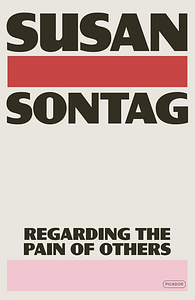Take a photo of a barcode or cover
4.5!! susan sontag is so great, she writes SO clearly, concisely, and her arguments land with impact. it started getting a little confusing around ch 7 or so when she began to contest all her previous arguments (in the older “On Photography” and also in her prior chapters). it’s a good practice, to be sure, but i was left feeling uncertain of where she stood: is atrocity photography a form of exploitative “tourism” or is that exact opinion elitist and out of touch? maybe there isn’t one answer. but i did feel like i understood her argument up until that point in the book. i will maybe reread for clarity (it’s a short read)! she wrote this in the early aughts and i’d be REALLY curious to see what she would’ve thought about the way photos and especially VIDEOS of atrocities/suffering interrupt (or arguably blend into) our social media timelines, and the engagement in social-media-politics particularly post-2020. would she see that as people “doing” something, responding to the call to action? or is it just a new form of passivity in response to the horrific images that inundate us? i read this book immediately following the online debate surrounding the stark contrast in reaction/media attention devoted to the titanic submersible VS. the migrant ship in turkey. i didn’t get perfect analysis to apply to that from this reading, even though sontag DOES comment on the class differential that often exists between the more privileged spectator (/news-reader) and the sufferer of war/atrocity, usually in some far-off land. but she couldn’t help me make sense of what to ME was so fascinating about the submersible situation: how the masses react when those suffering are deemed to have “deserved” it, or when the mainstream news outlets choose to devote conspicuously more stories to one tragedy than another (and the social status of the victims seems to make the difference). i super look forward to discussions on this!
also, last thought here— i LOLed at this passage: “The caption of a photograph is traditionally neutral informative: a date, a place, names. A reconnaissance photo from the First World War (the first war in which cameras were used extensively for military intelligence) was unlikely to be captioned ‘Can’t wait to overrun this!’ or the X-ray of a multiple fracture to be annotated “Patient will probably have a limp!’” like… that IS some present-day soldier’s instagram caption, i know it
also, last thought here— i LOLed at this passage: “The caption of a photograph is traditionally neutral informative: a date, a place, names. A reconnaissance photo from the First World War (the first war in which cameras were used extensively for military intelligence) was unlikely to be captioned ‘Can’t wait to overrun this!’ or the X-ray of a multiple fracture to be annotated “Patient will probably have a limp!’” like… that IS some present-day soldier’s instagram caption, i know it
challenging
dark
emotional
informative
reflective
sad
tense
medium-paced
challenging
reflective
fast-paced
Reading this in the 2020s was such a surreal experience. People have more access to images of brutality than ever before, and yet we are still living in the world of Virginia Woolf's imagined photographs of the Spanish Civil War. Thinking about the conflicts going on right now, it's hard to imagine how it's possible to justify the atrocities being committed. Sontag, as usual, makes it crystal clear: a picture is worth a thousand words, but which words we use is a matter of debate. There is always a justification for violence, no matter how flimsy, which is why the camera has not ended but merely shaped conflicts across the globe. In other words: a photo may make us want to stop violence, but stopping violence always depends on understanding who is perpetrating it.
emotional
hopeful
informative
inspiring
reflective
fast-paced
dark
informative
reflective
medium-paced
challenging
informative
reflective
slow-paced
informative
reflective
fast-paced
challenging
dark
reflective
fast-paced
challenging
dark
reflective
slow-paced





